5th Wheel Towing - How Much Truck Do You Need?
So, you have your eye on a new 5th wheel and now you’re wondering how much truck do you need to pull it. You’ve come to the right place.
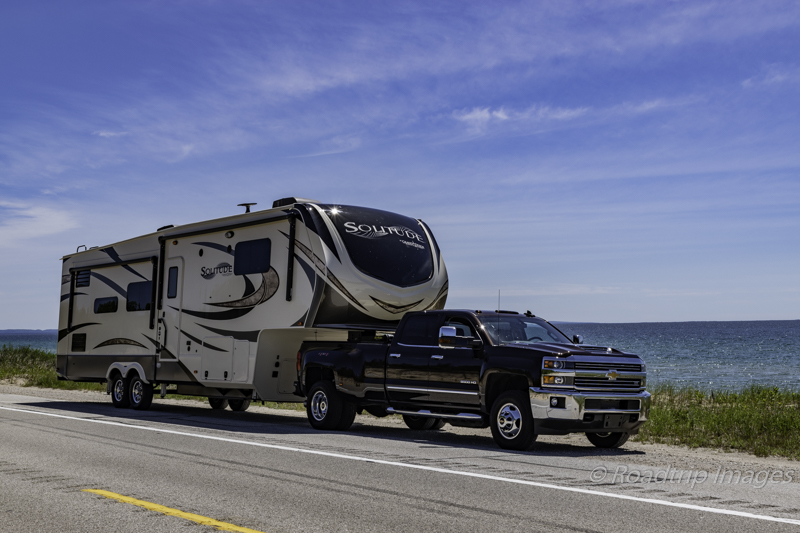
To dually or not to dually...
There’s a lot of confusion and misinformation on the social media sites about what size truck you need to pull your 5th wheel trailer. Many seem to sugest if you have a 3/4 ton diesel or better you can pull just about anything. And judging from what we see on the road that seems to be the general belief. We see some HUGE 5th wheels being towed by trucks that are obviously overloaded. The big thing that people want to avoid is stepping up to a dual rear wheel (DRW) truck, or dually, as they’re called. If it needs to be your daily driver, I get it. They are a bit more cumbersome to drive around town.
When it comes to safety however, you shouldn’t mess around. Get the right truck for the load you will be hauling. Or if you must stay with a single rear wheel (SRW) short bed truck, get a 5th wheel that fits inside the capacities of the truck. Trying to pull a 42′ toy hauler with a 3/4 ton pickup is just asking for trouble. Maybe not right away but eventually something’s going to go wrong. And that something could result in injury. To you or those around you on the highway. Today’s big diesel engines that the Big 3 automakers are putting in trucks are capable of pulling some really big loads. But engine power is generally not the limiting factor. Payload capacity is. And payload capacity is determined by the suspension and the number of tires carrying the load. Air bags don’t increase this capacity. The other key capacity is the towing rating listed for the truck. In addition to the payload this rating is generally indicating how heavy of a trailer the truck can safely stop.
So let’s break down some of these ratings and look at some real world numbers.
Trailer Manufacturers Ratings
Most people will have some idea what 5th wheel they’d like to buy so let’s start with that. How heavy is it? There’s two ways to find that out. The easiest is to go online and look at the brochure from the manufacturer. There should be a specs page near the back with the capacities listed. The one for our rig is shown below. Ours is the 344GK from Grand Design. It shows a UVW or Unladen Vehicle Weight of 12,600 pounds. This is the empty weight of the trailer. It’s important to note this is with empty tanks and is also an estimate. The actual weight will probably be a bit higher based on options installed. It also shows a hitch weight (pin weight) of 2,500 pounds. This is the weight of the empty trailer resting on the truck via the 5th wheel pin box. Unless you go camping with nothing in your rig, your pin weight will be higher. Much higher. If you can visit the actual trailer you’re interested in and look at the capacity sticker that’s even better. It will have the actual numbers for that rig.
You’ll notice that the pin weight is around 20% of the total trailer weight (19.8% to be exact). I’ve seen some say to estimate 15% but that may be too low. It does depend on the trailer design however. The next step is to make an estimate of how much cargo you’ll be adding to your rig. This is a tough one unless you have some prior knowledge from another rig. If you are an occasional camper and carry just the basic items, figure 1,000-1,500 pounds. If you really load it up go 2,000-2,500 pounds. Just as a point of comparison we travel full time in ours so I estimated 3,000 pounds. Once we weighed it we found we had 3,400 pounds on board. It pays to be conservative with your estimates. Also don’t forget if you carry any water in the fresh water tank that has to be added too. 8.4 pounds per gallon. Most of us carry some in the tank and that weight adds up.
As I mentioned, I estimated we’d add 3,000 pounds to the rig. Starting with an empty weight of 12,600 that would put us at 15,600 pounds. Figuring 20% of the total weight would rest on the pin that gives me an estimate of 3,120 pounds of weight added to the truck. We’ll use that number in the next section for the truck payload capacity. Also make note of the trailers Gross Vehicle Weight Rating or GVWR in the specs. This is the most the trailer and its contents can safely weigh. For our rig it’s 16,800 pounds.
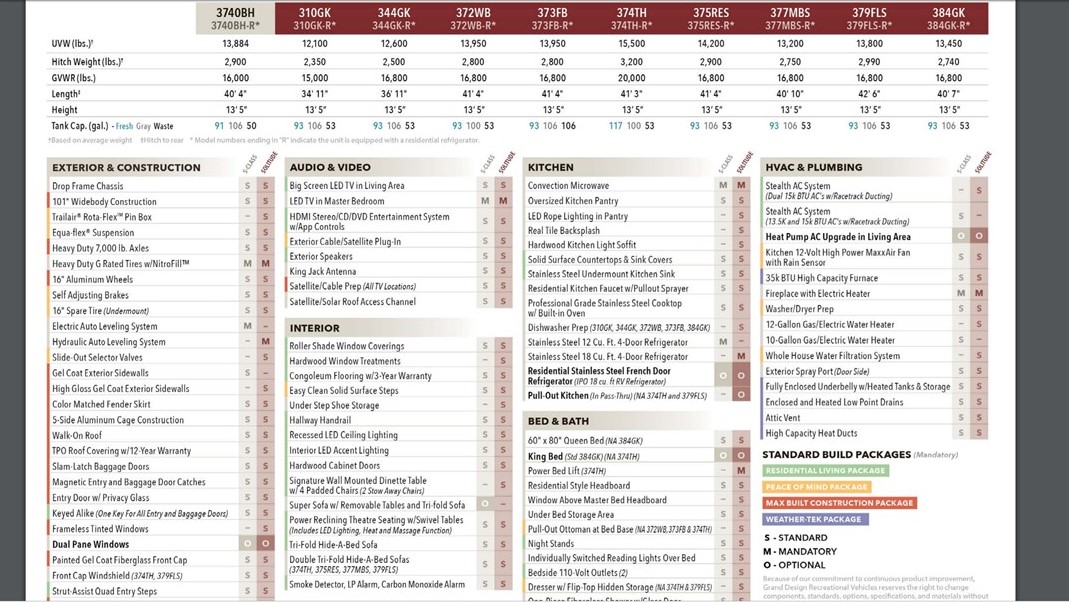
Truck Manufacturers Ratings
Now that we have an estimate of how much we’ll be adding to the truck (3,120 pounds) we can turn our attention to the various ratings for pickup trucks. The key number to start with is the payload capacity. If you don’t have access to the actual truck you can again look at the specs online. I’ve listed the specs page for our truck below. It’s a 2018 Chevy Silverado 1 ton diesel. It shows both the SRW and DRW capacities.
At first glance it looks like 3,120 pounds will fit inside the payload capacity of a SRW truck listed at 3,843 pounds. Hooray! We don’t need a dually! OK, not so fast. First, just like with the trailer specs, that 3,843 number is for a stripped down truck. Once all the options are added the real number will be less. A lot less. Also, the people weight has to added in so figure 300 pounds, maybe more, maybe less. Only you can estimate that. Now add in the weight of the 5th wheel hitch fastened to the bed of the truck. 150 pounds? As you can see it adds up. Let’s walk through the numbers from our truck:
- Trailer pin weight – 3120 pounds
- People weight – 300 pounds
- B&W Companion hitch – 163 pounds
- Toolbox & tools – 200 pounds
- Odds & ends – 50 pounds
Total payload = 3,833 pounds
So our estimated load was right at the limit of the SRW rating for payload. Now for the bad news. The real truck with all the options has a payload capacity of 3,433 pounds, 400 pounds less. What?!?! Now I’m over. And if I want to add anything else like an auxiliary fuel tank I’ll be even more over. And what if my pin weight is more than what I estimated (it was) what then? Guess we need to look at a dually. The DRW 1 ton diesel has a payload rating in the specs of 4,930 pounds. Unfortunately the real truck we bought was 4,534. Still more than enough for the 3,833 pounds we estimated. This capacity sticker is on the drivers side door frame. Our is shown below.
The other key rating to look at is the towing capacity. The SRW truck is rated at 17,000 pounds for the 5th wheel configuration and the DRW is rated at 22,700 pounds. Our trailer has a GVWR of 16,800 pounds so technically both trucks are OK there.
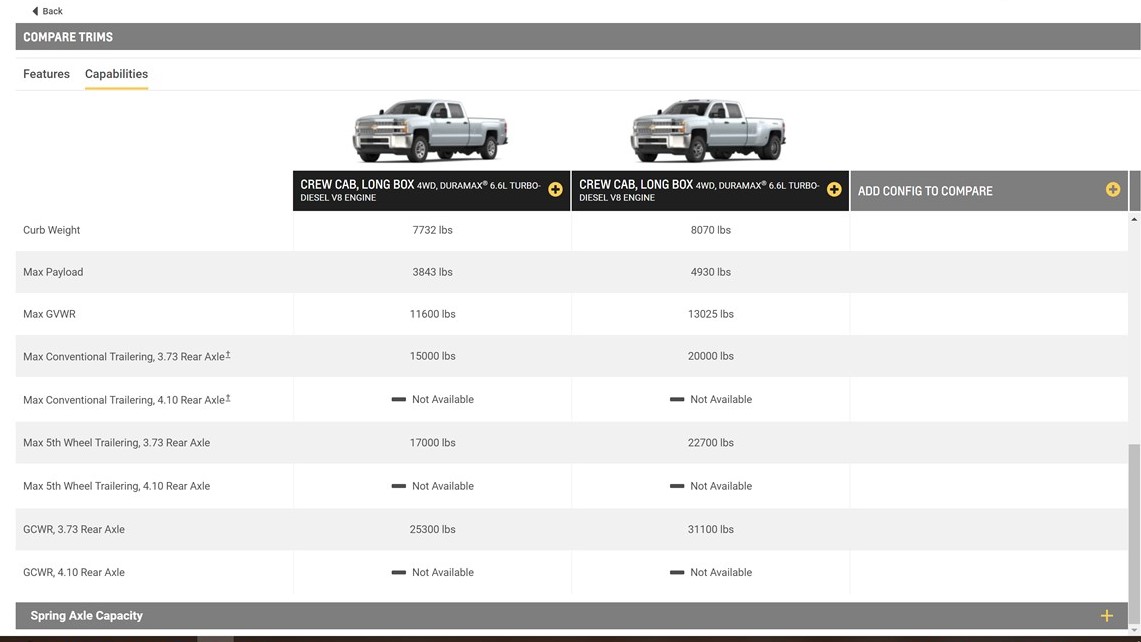
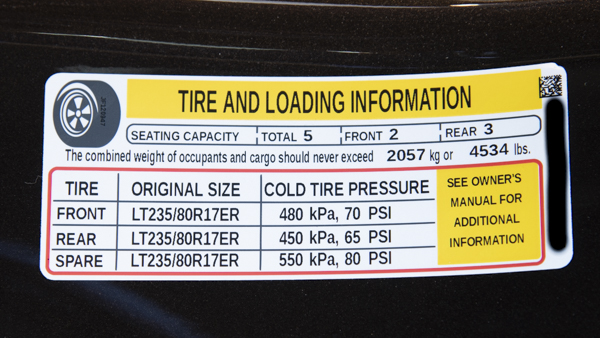
Real Weights - The CAT Scale
So based on those estimates I reluctantly decided to go with a dually. I really did want to stay with a SRW truck but it looked like we were just too far over. I didn’t want to take the risk of running overloaded, especially with as much as we travel since we do it full time. A SRW just wouldn’t be enough truck. So how’d we do? How close were our estimates? To find out you have to get the rig weighed. Enter the CAT Scale.
You’ve probably seen the signs at the truck stops. The CAT Scale logo is pretty much standard at all U.S. based truck stops. The process is pretty simple but you need to do it twice. Make sure you have a full tank of fuel in the truck and the tanks in the trailer are how you normally run. Maybe 1/4 to 1/3 of a tank of water probably. The waste tanks empty. Just drive up on the scale platform with the rig attached. The scale is segmented into 3 or 4 pads to weigh the axles independently. Position the truck front axle on the first pad. The truck’s rear axle goes on the second pad and the trailer axles go on the third pad. Now press the button on the speaker and have all the passengers in the truck. They’ll ask for a truck number but just tell them you’re a private RV and you need all three axle weights. They’ll then tell you you’re all set and come inside to pay. Around $11.50 currently.
You’ll get the weight ticket showing all the weights. Ours is below left. Then go unhook the 5th wheel and run through again with just the truck. We need to get the truck weight by itself. If you do this on the same day the second weighing is only $2.00. Same process as before but tell them it’s a second weighing and give them the weigh number on the bottom left of the page. Ours is below, right.
With these numbers we can see where we’re at:
25,260(total) – 9,300(truck) = 15,960 for the loaded trailer. I estimated 15,600
15,960(trailer) – 12,520(trailer axle) = 3,440 for the pin weight. I estimated 3,120.
So if I substitute 3,440 in for the pin weight:
- Trailer pin weight – 3,440 pounds
- People weight – 300 pounds
- B&W Companion hitch – 163 pounds
- Toolbox & tools – 200 pounds
- Odds & ends – 50 pounds
Total payload = 4,153 pounds. A full 710 pounds over the payload capacity of a real world SRW truck. Going with the dually was clearly the right choice. I’ve included a summary page and the truck capacities below the CAT scale results. One other number to note is the rear axle capacity of the truck. From the weight ticket we have 7,580 pounds on the rear axle of the truck when we’re loaded. The capacity for a SRW truck is 7,050. So I’m over there as well for a SRW truck. Just another checkpoint. Again, adding air bags won’t increase this capacity. It may level the truck bed but the rear axle is still overloaded by 530 pounds. At this point you just need more tires carrying the load.
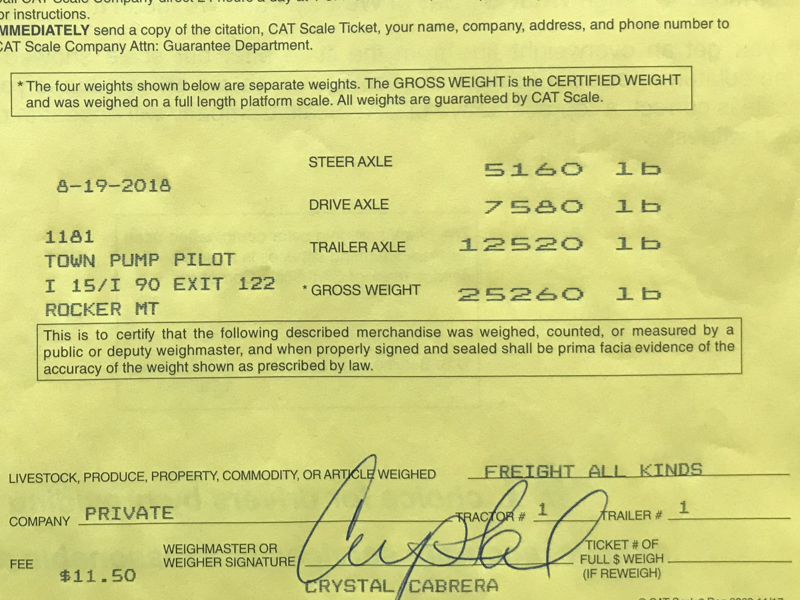
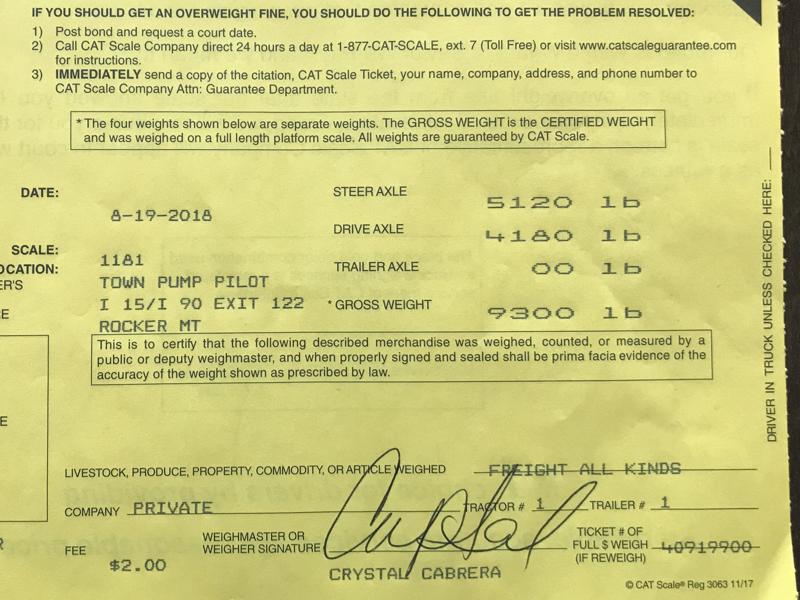
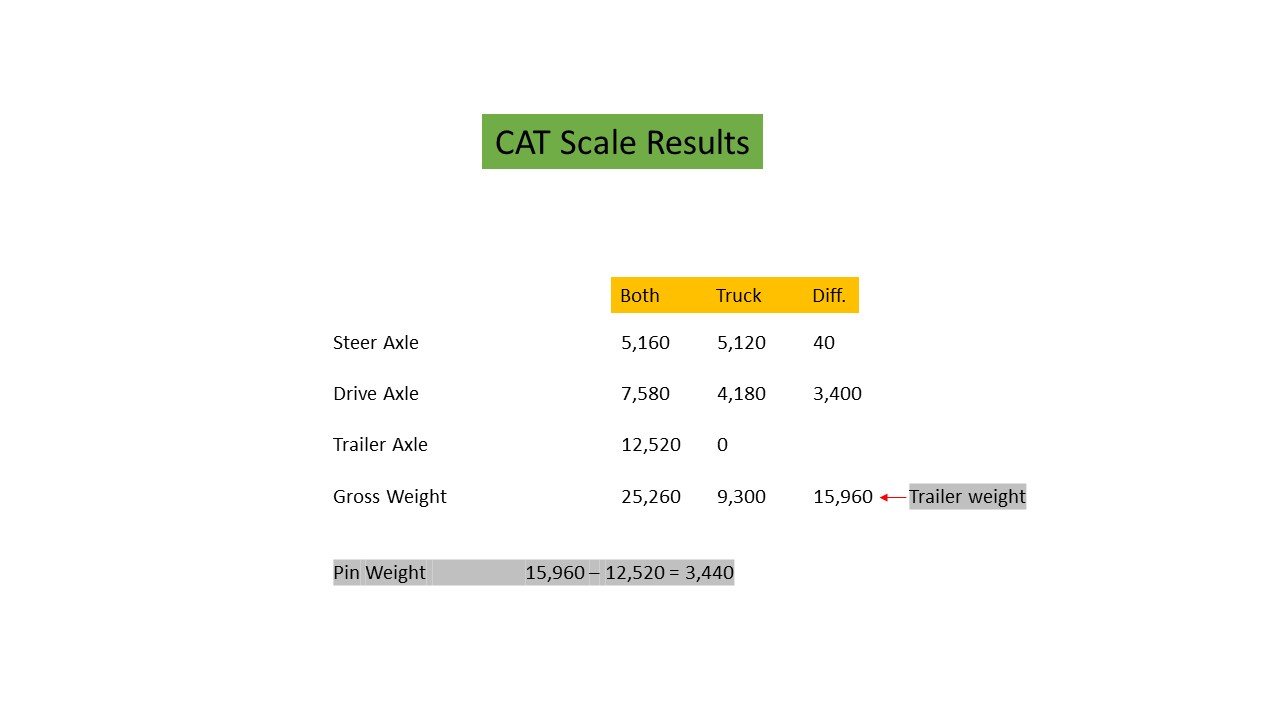
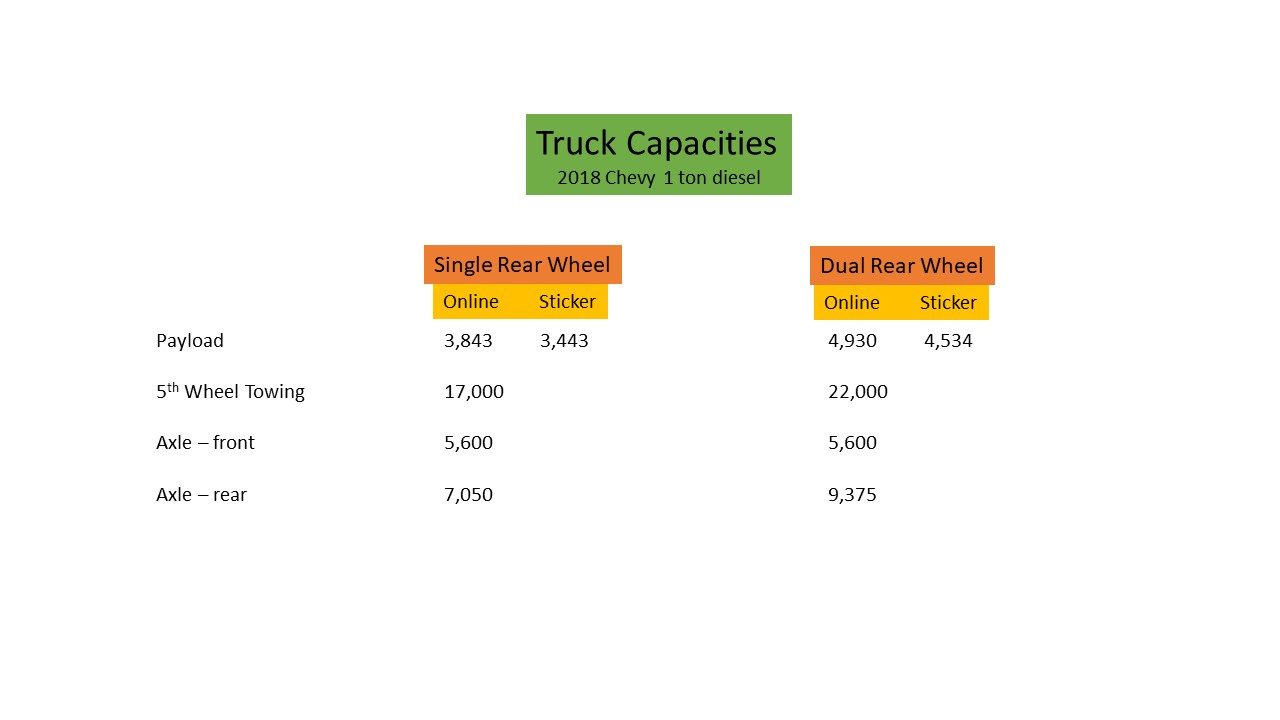
Final Thoughts
Towing ratings seem to be a hot topic online. There are a lot of opinions about how big a truck you need and how “my SRW truck pulls it just fine. No problems at all”. The only way to cut through that is to run the numbers. Real numbers not optimistic ones. I estimated conservatively and I still under estimated. Most people add way more weight to their rigs than they think. And they tend to underestimate how much load is on their truck. Once you have good information then you can decide what to do.
Hopefully this information helped. The process is a little involved as there isn’t a simple yes or no answer to “is my truck big enough”. If you find your situation to be right on the edge of what a SRW wheel can handle you have a decision to make. If you use it that way only occasionally you may be able to get by. Just drive cautiously and don’t push it. But please don’t run a severely overloaded rig. For your safety and those around you.
Subscribe and Get Free E-Book!

7 Comments
Leave a comment Cancel reply
This site uses Akismet to reduce spam. Learn how your comment data is processed.





Dave :
You added some items twice, 5w hitch, people, tool box. If I read that right. let me know. I would also go with a dually .
Thanks for the info,
Rick
Hi Rick. Thanks for the comment. I’m pretty sure the math is correct. It’s true the 9300# for the truck has those items in there but that calculation is just for determining the pin weight of the loaded trailer. For payload on the truck, we have no measured weights other than the pin weight so we have to add them up individually. That calculation doesn’t use the 9300# number.
Hi Rick.
First, thank you very much for the video and this blog; was about to make a big mistake awhile back and then saw this. Whew. It should be a law that RV dealerships have to do this payload estimate, or at least point you at someplace to do it, rather than solely focussing on towing capacity! It’s pretty clear to me now after seeing lots more info like this that there are MANY overloaded trucks pulling 5th wheels on the road.
I was trying to sanity check my own estimates by using your actual numbers, and built a spreadsheet for it. I may be missing something, but… I think you do have measured weights for the truck payload: gross (9300) minus curb weight (8070 from the Chevy info, undoubtedly wrong) = actual payload (1230 here). If you used your actual curb weight and then add your 3440 pin weight, this is your total payload when towing, right? And that is what you need to compare against the max payload of your truck.
// Bryan
Bryan, thanks for the comment. Just want to clarify some of the terms in your comment. First, I don’t know the actual curb weight of the truck. I never weighed it without people or the 5th wheel hitch, etc. The 9300 pounds figure is the truck with those things added but without the trailer load on it. With the trailer attached and fully loaded it adds another 3400 pounds to the 9300 pounds. So, the payload is all the weight that you add to the truck. People, B&W hitch, toolbox, trailer, etc. The payload capacity is what the truck can safely carry. In my case 4530 pounds. Hope that helps.
Thanks Dave. I get how you calculated all of this, which was excellent; I’m just pointing out one more piece of useful data I realized was available while I was building my spreadsheet.
Your curb weight should be on the Trailering Information sticker on the door frame. As an example, my 2020 Chevy (3500 diesel SRW 4×4 standard bed) shows a curb weight of 8355. I’m guessing yours is ~ 8466, based on the delta between the brochure and actual payload on your truck (396): pretty sure this is just the additional curb weight so 8070 (brochure curb) + 396 = 8466 (actual curb). Probably not exact, but close.
Whoops, I see I picked up and used the previous commenters name; sorry Dave.
Yes, my comment was meant for you Dave!
Should I say Dave one more time os was that enough? 😉
No worries Bryan. Take care.